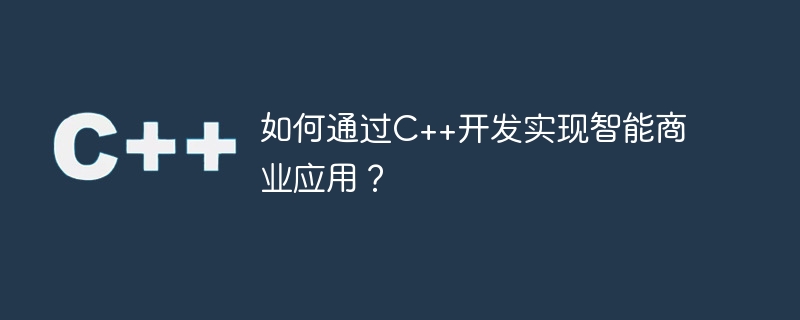Home >Backend Development >C++ >How to implement intelligent business applications through C++ development?
How to implement intelligent business applications through C++ development?
- WBOYWBOYWBOYWBOYWBOYWBOYWBOYWBOYWBOYWBOYWBOYWBOYWBOriginal
- 2023-08-25 17:30:35788browse

How to implement intelligent business applications through C development?
Introduction:
With the continuous development of artificial intelligence (AI) technology, more and more companies are beginning to apply intelligent business applications to their businesses. As a high-performance programming language, C has great advantages for developing intelligent business applications. This article will introduce how to use C to develop intelligent business applications and provide some code examples to help readers better understand.
Part 1: Understand the basics of C
Before we start developing intelligent business applications, we first need to understand the basics of C. As an object-oriented programming language, C has strong scalability and flexibility. The following are some basic concepts and usage of C for readers' reference:
- Classes and objects: C is an object-oriented programming language, and classes are an important concept in C. A class defines a set of properties and methods, and an object is an instance of this class.
class Person {
private:
string name;
int age;
public:
void setName(string n) {
name = n;
}
void setAge(int a) {
age = a;
}
string getName() {
return name;
}
int getAge() {
return age;
}
};- Inheritance: C supports the inheritance relationship between classes. Subclasses can inherit the attributes and methods of the parent class and expand on this basis.
class Student : public Person {
private:
string school;
public:
void setSchool(string s) {
school = s;
}
string getSchool() {
return school;
}
};- Polymorphism: C supports polymorphic programming, and polymorphism can be achieved through virtual functions.
class Shape {
public:
virtual void draw() = 0;
};
class Rectangle : public Shape {
public:
void draw() {
cout << "Drawing a rectangle" << endl;
}
};
class Circle : public Shape {
public:
void draw() {
cout << "Drawing a circle" << endl;
}
};Part 2: Using C to develop intelligent business applications
After becoming familiar with the basic knowledge of C, we can start to use C to develop intelligent business applications. The following are some common application scenarios and corresponding code examples for readers' reference and learning.
- Image processing application: In intelligent business applications, image processing is a very important link. The following is a sample code that uses the OpenCV library to implement image cropping.
#include <opencv2/opencv.hpp>
using namespace cv;
int main() {
Mat image = imread("input.jpg");
Rect roi(100, 100, 200, 200);
Mat crop = image(roi);
imwrite("output.jpg", crop);
return 0;
}- Data mining applications: In intelligent business applications, data mining can help enterprises discover valuable information hidden in large amounts of data. The following is a sample code that uses C to implement the K-means algorithm.
#include <iostream>
#include <vector>
#include <cmath>
using namespace std;
int main() {
vector<float> data = {1, 2, 3, 4, 5, 6, 7, 8, 9, 10};
int k = 2;
vector<float> means = {1, 5};
vector<int> labels(data.size());
for (int i = 0; i < data.size(); i++) {
float min_distance = INFINITY;
int min_index = 0;
for (int j = 0; j < k; j++) {
float distance = abs(data[i] - means[j]);
if (distance < min_distance) {
min_distance = distance;
min_index = j;
}
}
labels[i] = min_index;
}
for (int i = 0; i < data.size(); i++) {
cout << "Data: " << data[i] << ", Label: " << labels[i] << endl;
}
return 0;
}Part 3: Summary and Outlook
Through the introduction of this article, we have learned how to use C to develop intelligent business applications, and provided some code examples to help readers better understand. As artificial intelligence technology continues to develop, the need to use C to develop intelligent business applications will become greater and greater. We hope that readers can further master the skills of developing intelligent business applications in C through studying this article, and contribute to the development of enterprises.
Reference materials:
- C Tutorial - https://www.runoob.com/cplusplus/cpp-tutorial.html
- OpenCV official documentation - https: //docs.opencv.org/
- 《C Primer Fifth Edition》
The above is the detailed content of How to implement intelligent business applications through C++ development?. For more information, please follow other related articles on the PHP Chinese website!

